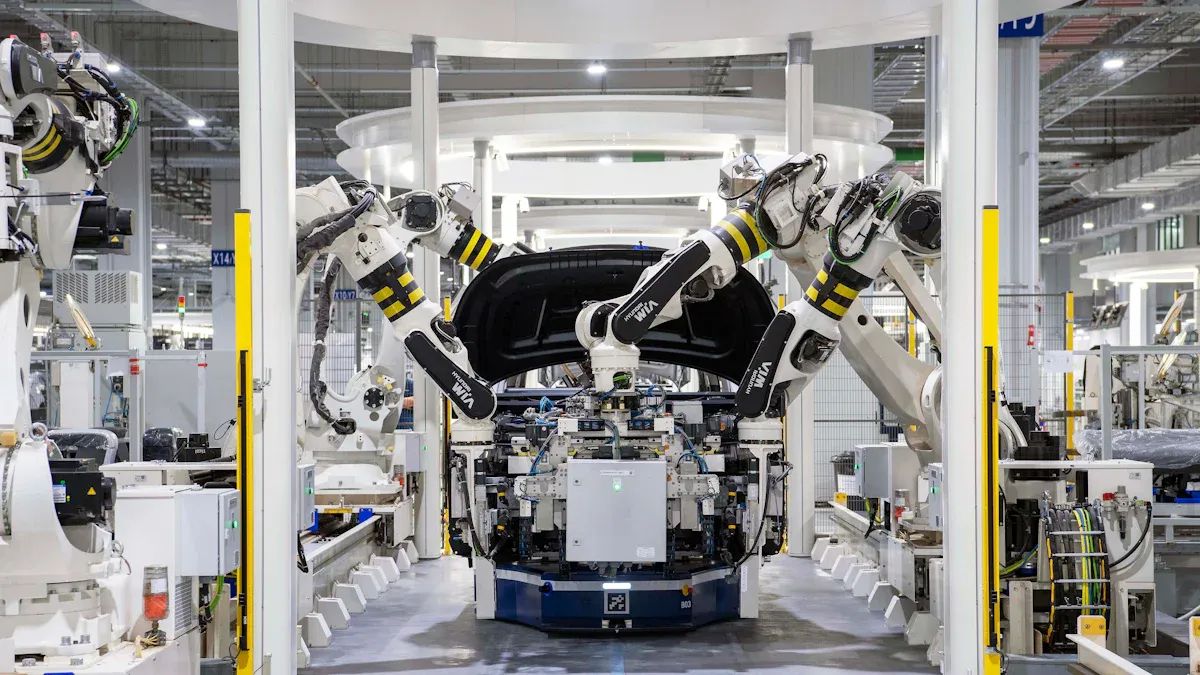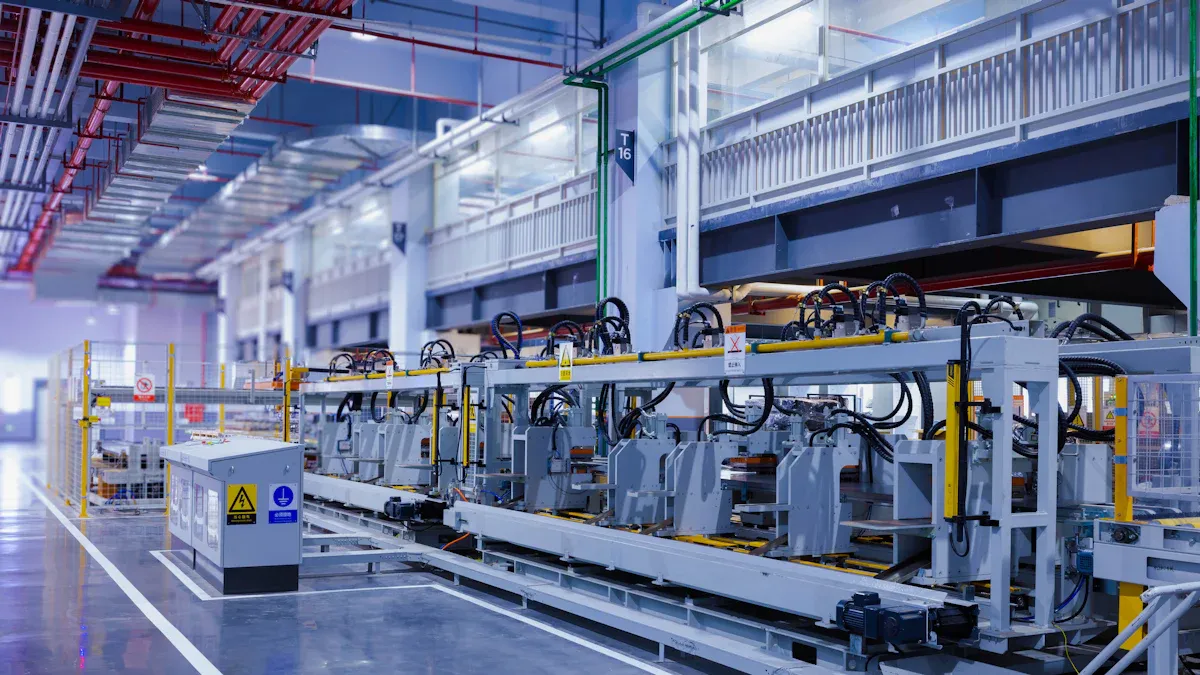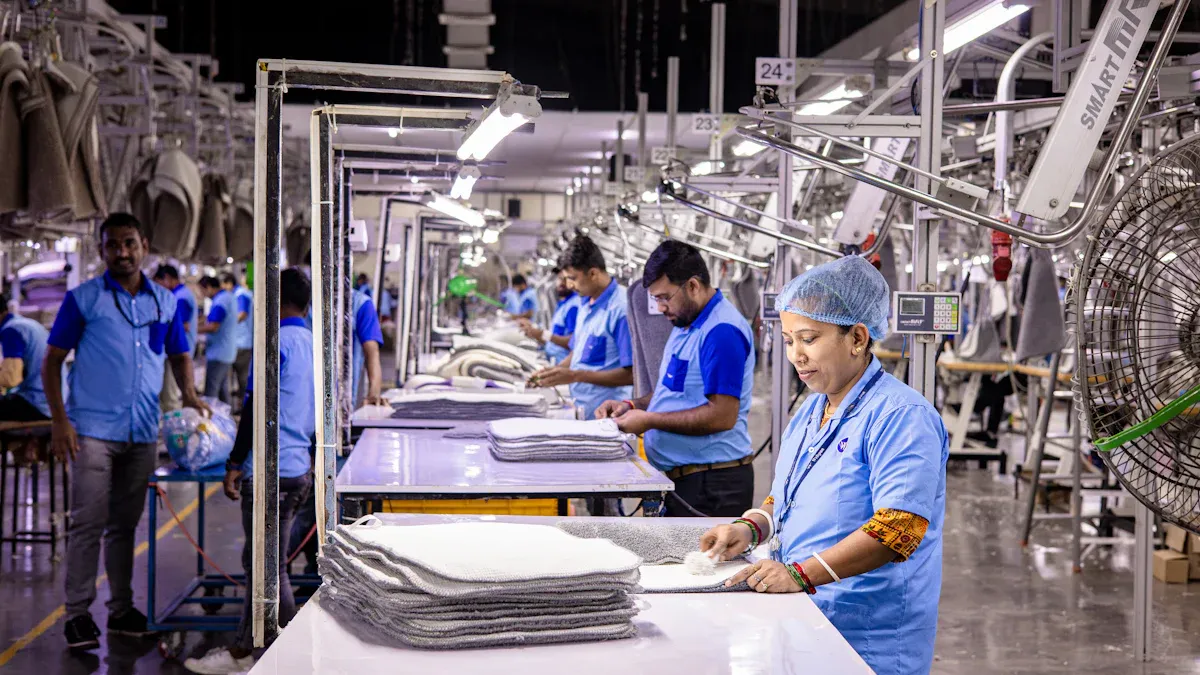
Many companies now seek a blowing molding machine that offers smart features and energy savings. For instance, a PC blowing bottle machine is ideal for producing strong, clear bottles, while a PE blowing bottle machine excels in creating flexible, durable containers. Additionally, a plastic blowing machine enables factories to manufacture a wide variety of products with less waste and reduced energy consumption. Current market trends highlight that businesses prioritize automation, AI, and sustainable practices to enhance quality and lower costs.
Automation and Smart Technology in Blow Molding Machine Selection

Advanced Controls and Monitoring
Modern blowing molding machines use advanced controls to make production easier and more reliable. Operators can adjust settings with user-friendly interfaces. These machines often include:
- Dynamic mold temperature control for quick heating and cooling.
- Real-time temperature monitoring with smart sensors.
- Automated diagnostics that spot and fix problems fast.
- PID control systems for precise temperature changes.
- Integration with quality control systems to prevent defects.
These features help companies produce high-quality bottles with less waste and fewer errors. Automation also boosts efficiency and keeps production running smoothly.
Integration with Industry 4.0 and IoT
Industry 4.0 and IoT have changed how factories use blowing molding machines. Machines now collect and share data in real time. This helps operators make better decisions and improve efficiency. The table below shows some key ways these technologies help:
| Aspect | Explanation |
|---|---|
| Data Analytics for Optimization | Big data helps optimize production and predict maintenance needs. |
| Digital Twin Technology | Virtual models give insights to improve operations. |
| Supply Chain Integration | Better communication improves inventory and reduces delays. |
| Automation | Faster production and better quality control. |
| Machine Communication | Machines share data for smarter actions. |
| AI and Machine Learning | Smarter decisions and less downtime. |
Predictive Maintenance and AI Capabilities
AI and predictive maintenance are big steps forward for blowing molding machines. These systems watch for signs of wear or problems. They can alert operators before a breakdown happens. Some machines use AI-driven defect detection that learns and gets better over time. This means less downtime, lower repair costs, and longer machine life. Companies save money and keep production on track.
Sustainability and Energy Efficiency in Blow Molding Machine Choices

Energy-Saving Features and Reduced Carbon Footprint
Many companies now look for machines that help save energy and lower their carbon footprint. All-electric blow molding machines use servo motors and smart controls to cut energy use by up to 50%. These machines also run quieter and need less maintenance. The table below shows how different machines compare:
| Machine Type | Energy Consumption (kWh/kg) | Key Energy-Saving Features and Benefits |
|---|---|---|
| Hydraulic | 0.58 – 0.85 | Older technology, higher energy use |
| All-Electric | 0.38 – 0.55 | Servo motors, energy savings, no oil leaks, quieter |
Other energy-saving features include:
- Variable speed drives that adjust power use.
- Energy recovery systems that reuse energy.
- Smart standby modes that save power when machines are idle.
These features help companies use less energy and reduce waste.
Use of Biodegradable and Recycled Materials
Sustainability matters more than ever. Many factories now use biodegradable and recycled materials in their blowing molding machine processes. Machines with advanced heating and control systems can handle these materials well. This helps companies make bottles and containers that are better for the planet. Recycling compressed air and using adjustable speed motors also cut energy use and costs. More people want products from companies that care about the environment, so using these materials can boost sales.
Compliance with Environmental Standards
Manufacturers must follow strict environmental rules. They meet standards like SPI, ASTM, ISO 13485, RoHS, REACH, and FDA. These rules make sure products are safe and eco-friendly. Companies stay up to date with new laws and train workers to use machines the right way. They also invest in machines that can process recycled and biodegradable materials. This helps them keep their products safe, protect the environment, and reach more customers.
Customization and Flexibility in Blow Molding Machine Applications
Modular Machine Design for Versatility
Manufacturers want machines that can grow with their business. Modular machine design makes this possible. With this approach, companies can add or remove parts to fit their needs. Some key benefits include:
- Easy customization and scalability for different production sizes.
- Flexibility for both small and large manufacturing jobs.
- Advanced controls that make operation simple and precise.
- Energy-saving features that help lower costs.
- Support for automation in many industries, like food packaging and automotive.
This design lets companies quickly adjust to new products or changes in demand. They can also keep costs down while staying efficient.
Adaptability to Product Changes and Multi-Material Use
Today’s markets change fast. Companies need machines that can keep up. Flexible blow molding machines help them do this. These machines allow real-time changes to production settings. Operators can switch between making lightweight bottles and strong containers with ease. They can also use different materials, like rubber or plastic, for special products. Smart features, such as AI and IoT, help monitor production and make quick adjustments. This flexibility helps companies respond to trends and customer needs right away.
Quick Changeover Systems
Quick changeover systems save time and boost productivity. Leading machines can switch molds in just 15 minutes. Color or material changes take about an hour. These fast changes mean less downtime and more products made each year. Better heaters and mold positioning tools also help reduce delays. When companies spend less time changing setups, they can focus on making more products and meeting customer demands.
Quality Assurance and Compliance in Blow Molding Machine Operations
Consistent Product Quality and In-Line Inspection
Factories want every bottle or container to meet the same high standard. They use several smart technologies to make this happen:
- Advanced vision inspection systems check each product for defects right on the production line. These systems use special cameras and imaging to spot problems fast.
- Automation helps reduce mistakes that people might make. Machines keep the process steady and reliable.
- Customizing the blowing molding machine for each job means it can handle different shapes and sizes without losing quality.
- Advanced monitoring systems track every step in real time. If something goes wrong, the system alerts workers right away.
These tools help companies catch issues early and keep quality high from start to finish.
Meeting Regulatory and Industry Standards
Companies must follow strict rules to keep products safe and reliable. They meet standards set by groups like ISO, ASTM, and the FDA. These rules cover everything from the materials used to the way machines run. Workers get special training to use the machines correctly. Companies also keep records to show they follow the rules. Meeting these standards helps them sell products in more places and builds trust with customers.
Product Classification: PC Blowing Bottle Machine, PE Blowing Bottle Machine, Plastic Blowing Machine
Different machines work best for different jobs. Here’s a quick look at how they compare:
| Machine Type | Raw Material(s) | Product Classification | Typical Applications |
|---|---|---|---|
| PC Blowing Bottle Machine | Polycarbonate (PC) | Machines for PC bottles | Durable, clear bottles for packaging, personal care |
| PE Blowing Bottle Machine | Polyethylene (PE), HDPE | Machines for PE/HDPE bottles | Water bottles, barrels, flexible containers |
| Plastic Blowing Machine | PE, PVC, PP, PS, PC, more | Machines for many plastics, various methods | Bottles, toys, containers, automotive parts |
Each type of blowing molding machine fits a special need. Some focus on strength and clarity, while others offer flexibility or handle many materials.
Cost-Effectiveness and ROI of Blow Molding Machine Investments
Initial Investment vs. Long-Term Savings
Choosing the right blowing molding machine means looking at both the upfront cost and the savings over time. Some companies pick a semi-automatic machine because it costs less at first and is easier to set up. Others invest in a fully automatic machine, which costs more but saves money in the long run. The table below shows how these two options compare:
| Cost/Saving Factor | 4-Cavity Semi-Automatic Machine | 4-Cavity Fully Automatic Machine |
|---|---|---|
| Initial Machine Cost | Significantly lower, suitable for startups | Considerably higher, often 2.5 to 5 times more |
| Auxiliary Equipment Costs | Minimal, simpler setup | More extensive, includes preform handling systems |
| Installation & Commissioning | Simpler and less expensive | More complex, requires skilled technicians |
| Labor Cost per Bottle | Higher due to manual operation | Significantly lower due to automation |
| Material Scrap Rate | Potentially higher due to operator variability | Generally lower with precise process control |
| Energy Cost per Bottle | Can be higher due to lower output | Potentially lower with efficient design and higher output |
| Maintenance Complexity | Simpler mechanics, possibly more frequent minor repairs | More complex, requires specialized skills but built for durability |
| Typical Payback Period | Shorter due to lower initial cost | Longer, but yields higher ROI in long term |
A fully automatic machine may seem expensive, but it can pay for itself by cutting labor and material costs.
Operational Efficiency and Productivity Gains
Newer blowing molding machines help companies work faster and smarter. They use less energy and make more products in less time. Here are some ways these machines boost efficiency:
- They run faster and use less power, which lowers bills.
- Custom settings help reduce waste and improve product quality.
- Automation and data tools keep production steady and spot problems early.
- Lean manufacturing and teamwork with suppliers make the whole process smoother.
- Upgrading leads to less downtime, more profit, and greener operations.
These benefits help companies stay ahead in a busy market.
Maintenance and Downtime Costs
Maintenance can take time and money. Fully automatic machines need skilled workers for repairs, but they break down less often. Semi-automatic machines are easier to fix but may need more frequent attention. Companies that choose modern machines with smart features spend less time on repairs and keep production moving. Less downtime means more products and better profits.
Vendor Support and After-Sales Service for Blow Molding Machine Owners
Training and Technical Assistance
Good training and technical help make a big difference for machine owners. Vendors often offer programs that teach workers how to use the machine, follow safety rules, and fix common problems. These programs help teams run machines safely and keep them working well. Technical support can include regular check-ups, help with repairs, and advice on how to prevent problems. When workers know what to do, they can solve issues faster and keep the machine running longer. This support leads to less downtime and better product quality.
- Vendors provide training on machine functions and safety.
- Teams learn how to spot and fix problems quickly.
- Regular technical help keeps machines in top shape.
- Expert advice helps prevent breakdowns and saves money.
Availability of Spare Parts and Upgrades
Having the right spare parts and upgrades is key for long-term success. Quality parts help machines work better and last longer. When companies use the right parts, they avoid damage and keep the machine running smoothly. Upgrades can make machines more energy efficient and improve product quality. Quick access to parts means less waiting and more production. Preventive care, like changing parts before they break, also helps avoid big problems.
- Quality spare parts reduce failures and keep machines running.
- Upgrades improve energy use and product results.
- Fast access to parts means less downtime.
- Preventive maintenance extends machine life.
Ongoing Support and Service Agreements
Ongoing support keeps machines safe and reliable. Many companies follow best practices to make sure everything works well.
- Assign daily checks to team members to spot problems early.
- Clean oil filters often to avoid repairs.
- Inspect all safety features to keep workers safe.
- Check hoses every week and replace them if needed.
- Look at cylinders for leaks and make sure they line up right.
- Clean air filters on cabinets weekly to stop overheating.
- Fix problems the right way, not with quick fixes.
- Keep spare parts in stock to avoid delays.
- Never turn off safety features; safety comes first.
- Use service visits as a chance for staff to learn from experts.
Tip: A strong service agreement with the vendor helps companies get help fast and keep machines running smoothly.
Manufacturers should focus on automation, sustainability, customization, quality, cost, and vendor support.
- Each industry has unique needs, like cleanroom compatibility or mold versatility.
- Choose vendors with strong after-sales support, global service, and reliable machines.
- Future-ready technology helps boost efficiency and return on investment.
FAQ
What materials can a blow molding machine process?
A blow molding machine can handle many plastics. These include PC, PE, PET, PP, and PVC. Each material fits different product needs.
How does automation help in blow molding?
Automation speeds up production. It reduces mistakes and saves money. Workers can focus on quality checks instead of manual tasks.
Why is vendor support important for machine owners?
Vendor support helps owners fix problems fast. Good support means less downtime and better training. This keeps machines running smoothly.
Post time: Jul-14-2025
